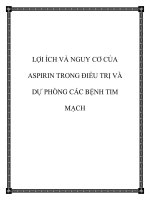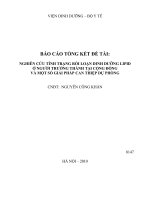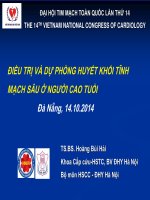Rối loạn nhịp nguy hiểm ở người bệnh suy tim phân tầng nguy, xử trí và dự phòng
Bạn đang xem bản rút gọn của tài liệu. Xem và tải ngay bản đầy đủ của tài liệu tại đây (6.36 MB, 54 trang )
Fatal cardiac arrhythmias in
patients with heart failure:
Risk stratification, treatment and
prevention
Dr. Reginald Liew
MA, MB BS (Hons), PhD, FRCP, FACC, FESC, FAsCC
Director/ Senior Consultant Cardiologist
The Harley Street Heart and Cancer Centre
Mount Elizabeth Novena Specialist Centre, Singapore
Outline of presentation
•
•
•
•
•
Incidence and epidemiology
Risk stratification for SCD
Role of ICDs for 1ry and 2ry prevention
Catheter ablation and drug treatment
Other considerations
Outline of presentation
•
•
•
•
•
Incidence and epidemiology
Risk stratification for SCD
Role of ICDs for 1ry and 2ry prevention
Catheter ablation and drug treatment
Other considerations
Incidence of Sudden Cardiac Death
SCD in post MI patients
• Atherosclerotic coronary artery disease
remain the most important underlying
substrate for accountable sudden cardiac
death.
• Survivors of myocardial infarction especially
with left ventricular dysfunction, is the high risk
population being focused on and where most
of the data has been available.
Events leading to SCD in post MI patients
Liew R; Heart 2010
Outline of presentation
•
•
•
•
•
Incidence and epidemiology
Risk stratification for SCD
Role of ICDs for 1ry and 2ry prevention
Catheter ablation and drug treatment
Other considerations
Which parameters will help identifying
patients who require ICD?
•
•
•
•
•
•
•
•
NYHA functional class
Non-sustained VT
QT dispersion and variability
Cardiac autonomic modulation (HRV,
BRS, HRT)
Signal –averaged ECG
Microvolt T wave alternans
EP testing
LVEF
Signal averaged ECG
•Late potential represents low
amplitude high frequency electrical
activity at the terminal portion of QRS.
Thought to be due to slow conduction
and delayed myocardial activation, a
marker of ischemic substrate.
•The prognostic value of SAECG had
been reported. In MUSTT trial, patients
with abnormal SAECG has higher rate
of arrhythmic and total mortality (36%
vs 13% 5 yr incidence) but the
sensitiviy and specificity was
inadequate to guide ICD therapy
Liew R; Heart 2010
Imaging the substrate
• Ischemia and scarring from CAD result in
abnormal myocardial substrate and predispose
to life-threatening arrhythmia
• Traditional tools in assessing LVEF include
2D echocardiogram and radionuclide imaging
• Cardiac MR has emerged as a promising tool
in risk assessment arena, providing accurate
measurements in LVEF and dimensions,
perfusion abnormality, infarct size and viability
assessment (DGE). DGE identified regional
fibrosis in NICM and ICM and correlates with
appropriate ICD Rx (Iles et al. JACC 2011)
Correlation of myocardial scar on
MRI with voltage map
Images from UCLA arrhythmia centre
Outline of presentation
•
•
•
•
•
Incidence and epidemiology
Risk stratification for SCD
Role of ICDs for 1ry and 2ry prevention
Catheter ablation and drug treatment
Other considerations
Implantable cardioverter defibrillators
• Useful to protect against
sudden arrhythmic death, but
have their own associated
risks
– Inappropriate shocks
– Need for regular generator
change
– Risk of infection
– May cause vicious cycle of
further arrhythmias due to
adrenergic drive
• Risk/ benefit ratio needs to
be discussed fully with pt and
parents
• General principles:
– Indicated in pts after aborted SCD (2rd prevention)
– Consider for 1ry prevention in patients at high risk of SCD
Clinical trials of ICD therapy
using LVEF as primary risk assessment tool
Benefit of ICD for SCD is offset in
early post MI
Impact of ICD therapy is Time dependent
Impact of ICD therapy is Time dependent
• The benefit of ICD early vs late post MI does not
seem to be similar.
• Potent reduction in total mortality by ICD has been
confirmed when implemented in a ICM population with
remote MI.
• Although SCD risk is highest early post MI, ICD does
not impact total mortality. ICD merely changes the
mode of death from arrhythmic death to nonarrhythmic/heart failure death.
• It seems that remodelling of ventricle early post MI
negates the ICD benefits, yet in late post MI when the
substrate becomes stable with healed scar tissue, reentrant arrhythmia is the primary mechanism for
mortality when ICD can significantly impact survival.
ACCF/AHA/HRS 2012 focused updated Guidelines
Device –based Therapy for Cardiac Rhythm
Abnormalities
ICD therapy is indicated in patients:
• who are survivors of cardiac arrest due to ventricular
fibrillation or hemodynamically unstable sustained VT after
evaluation to define the cause of the event and to exclude
any completely reversible causes. (Class I level A)
• with structural heart disease and spontaneous sustained
VT, whether hemodynamically stable or unstable. (Class I
level B)
• with syncope of undetermined origin with clinically
relevant, hemodynamically significant sustained VT or VF
induced at electrophysiological study. (Class I level B)
ACCF/AHA/HRS 2012 focused updated Guidelines
Device –based Therapy for Cardiac Rhythm
Abnormalities
ICD therapy is indicated in patients with:
• LVEF less than or equal to 35% due to prior MI who are
at least 40 days post-MI and are in NYHA functional
Class II or III. (Class I level A)
• LV dysfunction due to prior MI who are at least 40 days
post-MI, have an LVEF less than or equal to 30%, and
are in NYHA functional Class I. (Class I level A)
• nonsustained VT due to prior MI, LVEF less than or
equal to 40%, and inducible VF or sustained VT at
electrophysiological study. (Class I level B)
PRIMARY PREVENTION OF SCD WITH THE ICD
European Society of Cardiology
SUMMARY- SCD and ICDs in heart failure pts
• At present, other than LVEF measured at least
40 days post MI, there is no non-invasive or
invasive strategy that can reliably predict SCD risk
and guide ICD therapy, especially soon after MI.
• For early post MI patients, the management
directive is to maximize optimal medical therapy
and revascularization (early if not primary), and reevaulate LVEF at 40 days post MI or
revascularization for indication of ICD .
• For stable ischemic cardiomyopathy patient,
LVEF still provide the most validated and powerful
risk assessment to guide the need for prophylactic
ICD.
Outline of presentation
•
•
•
•
•
Incidence and epidemiology
Risk stratification for SCD
Role of ICDs for 1ry and 2ry prevention
Catheter ablation and drug treatment
Other considerations
MANAGEMENT OF SUSTAINED VT IN PATIENTS
WITH IHD
DRUGS FOR THE TREATMENT OF
VENTRICULAR ARRHYTHMIAS AND SCD
• Other than beta-blockers, no other AADs
have been shown in RCT to be effective in
primary management of patients with lifethreatening ventricular arrhythmias and
reducing the risk of SCD
• Each drug can potentially cause adverse
events, including pro-arrhythmia









